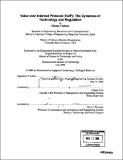Voice over Internet Protocol (VoIP) : the dynamics of technology and regulation
Author(s)
Vaishnav, Chintan
DownloadFull printable version (7.244Mb)
Alternative title
VoIP : the dynamics of technology and regulation
Other Contributors
Massachusetts Institute of Technology. Technology and Policy Program.
Advisor
Charles Fine.
Terms of use
Metadata
Show full item recordAbstract
"What Voice over Internet Protocol (VoIP) is going to do is start to weaken the foundation of the way we've done things for 100 years...Congress already should be discussing the next telecom bill," said Federal Communications Commission (FCC) Chairman Michael Powell in February 2004, before the United States Senate. The objective of this thesis is to study how VoIP challenges the incumbent US telecommunications act. The appearance of VoIP comes at a juncture when telecommunications system has already turned into a large-scale, complex system with multiple, competing infrastructures. VoIP, however, greatly augments the nested complexity by affording a technology that enables multiple architectures and business models for delivering the same voice (and often converged voice and data) service, while remaining agnostic to the underlying infrastructure. The VoIP-enabled architectures have very different capabilities and costs from one another. Many do not - or cannot - support social regulations such as emergency 911, wiretapping and disability access. Most exploit the economic arbitrage opportunities by evading access charges and universal service contributions. (cont.) Added to this is the combination of reduced asset specificity due to VoIP's layered architecture and a global standard based ubiquitous IP technology that frees the service providers of the need to own the delivery infrastructure, and enables them to offer service from anywhere globally. Such a misalignment - between regulatory obligations and technical capabilities - has the potential to incubate large-scale systemic failures due to lack of coordination between the local optimization focused private markets and the highly compartmentalized public institutions. The case of Communications Assistance for the Law Enforcement Act (CALEA) - also known as the wiretapping act - is taken to study its implications on VoIP. A system dynamics model is used for the analysis. Four policy lessons emerge through the process of arriving at the model and the subsequent sensitivity analysis. First, considering peer-to-peer (P2P) VoIP a non-issue for CALEA is exactly what might make it an issue. Second, if P2P VoIP aspires to be a telephony substitute, it will invite the threat of social regulation. Third, arms race between CALEA-compliant and non-compliant technologies may raise the cost of CALEA compliance. Fourth, prohibiting use of certain encryption techniques may help the LEA to keep their ability to wiretap intact, but it also deprives customers of the privacy the prohibited schemes would have offered, and thereby helps the Internet-crime.
Description
Thesis (S.M.)--Massachusetts Institute of Technology, Engineering Systems Division, Technology and Policy Program, 2006. Includes bibliographical references (p. 144-145).
Date issued
2006Department
Massachusetts Institute of Technology. Engineering Systems Division; Technology and Policy ProgramPublisher
Massachusetts Institute of Technology
Keywords
Technology and Policy Program.